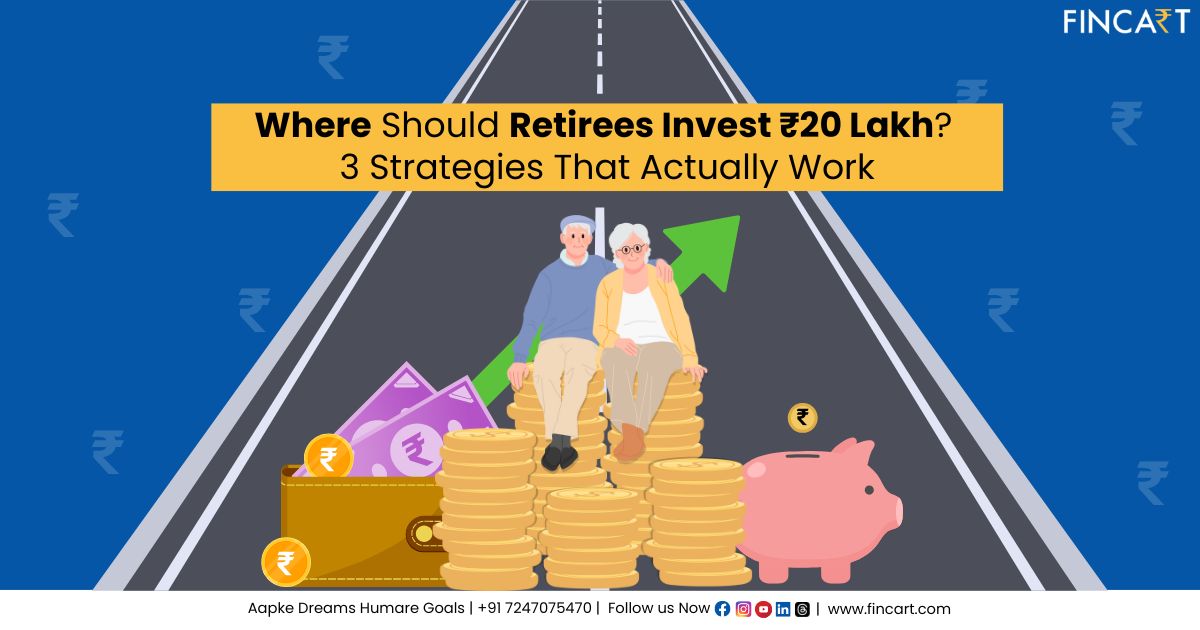Retirement brings peace, freedom—and a new kind of financial challenge for retirees. You’re no longer earning a paycheck, but your money still needs to work as hard as you did. That’s why a question we often hear at Fincart is: “Where should I invest ₹20 lakh after retirement?”
It’s a great question. But the right answer depends on your retirement goals—whether that’s generating steady income, growing your wealth, or building in some flexibility for life’s surprises.
In this blog, we’ll walk you through three smart ways to invest ₹20 lakh post-retirement. Each option is designed for a different kind of retiree and backed by our experience as a AMFI-registered investment advisor. Let’s help your money do what you need it to do.
Understanding What You Want From Your Retirement Corpus
Before deciding where to invest your ₹20 lakh, it’s important to pause and reflect on what you truly want from this money. Your goals will define the right investment path.
Ask yourself:
- Do I need a steady income every month or quarter?
If you’re relying on this corpus to manage household expenses post-retirement, prioritising predictable, low-risk income sources becomes crucial. - Am I looking to grow this money over time?
Maybe you don’t need the funds immediately, but want to build wealth—either for your future security or to leave a legacy for your children or grandchildren. - Do I want some flexibility to access this money when needed?
Life can be unpredictable. Medical emergencies, gifting, or travel plans may require occasional access to your savings without heavy penalties.
Each of these objectives leads to a different investment mix. The good news? With a thoughtful approach, you don’t have to choose just one—you can build a strategy that balances all three. Let’s explore how.
Case 1: Income First – For Retirees Who Need Regular Cash Flow
If your priority is consistent income, you’ll need to focus on safe, fixed-income products. The goal here is capital protection and predictable payouts—without taking on excessive market risk.
Strategy 1: Start With Senior Citizens’ Saving Scheme (SCSS)
Why it works:
- Backed by the Government of India
- 8.2% interest rate (as of April 2025)
- Quarterly payouts
- Maximum investment limit: ₹30 lakh
- Lock-in: 5 years (extendable)
How to use it:
If you haven’t already invested in SCSS, put as much of the ₹20 lakh here as possible. The payouts offer peace of mind and beat most traditional bank FDs in returns.
Strategy 2: SWP from Debt Mutual Funds
If you’ve already exhausted your SCSS limit or want additional income, consider a Systematic Withdrawal Plan (SWP) from a short-duration debt fund.
Why it works:
- Tax-efficient withdrawals (especially after 3 years)
- Flexibility to set monthly/quarterly withdrawals
- Potential for better post-tax returns vs. FDs
We usually recommend withdrawing no more than 6% annually to preserve your corpus.
Strategy 3: Add Equity Savings Funds for Inflation Protection
Relying entirely on fixed-income investments during retirement may seem safe, but it comes with a hidden risk—inflation. Over time, rising costs can quietly eat into your purchasing power, leaving you with less value than you started with.
That’s why it’s wise to allocate 25–30% of your retirement corpus to Equity Savings Funds, especially if you want your retirement income strategy to stay relevant and resilient over the years.
These funds typically consist of:
- Around 30% equity exposure – to provide growth and help your money beat inflation.
- 30–40% debt allocation – offering capital stability and regular interest income.
- Arbitrage positions – low-risk equity strategies that enhance tax efficiency.
This structure gives you a tax-optimized and future-ready investment mix—allowing for moderate returns, reduced volatility, and improved post-tax outcomes. Equity savings funds strike a balance between safety and growth, making them a smart addition to any retirement plan.
Case 2: Growth First – For Retirees Focused on Long-Term Wealth Building
Some retirees don’t need monthly income. Instead, they want to grow their wealth over the next 10–15 years—maybe to pass it on to children or to cover large future costs like healthcare or home renovation.
In that case, aggressive hybrid funds are your best bet.
Strategy: Invest in Aggressive Hybrid Mutual Funds
Why hybrid, not pure equity?
- They invest 65–75% in equities and the rest in debt
- The equity drives long-term growth
- The debt component cushions market volatility
Potential Returns:
Let’s say you invest your ₹20 lakh in a top-performing aggressive hybrid fund:
- In 5 years: ₹20 lakh could grow to ₹34–36 lakh
- In 10 years: Around ₹60 lakh
- In 15 years: You could cross ₹1 crore
These returns are based on 10-year rolling averages—not just best-case scenarios.
The Real Advantage
Remember the Covid crash in 2020? While the Sensex TRI fell over 38%, aggressive hybrid funds limited losses to around 28%. That’s the power of built-in diversification.
Pro tip: Choose funds with a strong track record across market cycles. Need help selecting? Fincart’s mutual fund investment planners are just a call away.
Case 3: Flexibility First – For Retirees Who Want Access + Growth
What if you want a little bit of both—growth + liquidity? Say, you’re mostly okay without income but want to dip into your corpus occasionally—for a medical need, a vacation, or a gift to your grandchild.
In that case, a balanced split strategy works beautifully.
Strategy: 50:50 in Equity & Debt
- ₹10 lakh in a flexi-cap equity fund
- ₹10 lakh in a short-duration debt fund
Why it works:
- The equity part grows your money over time
- The debt part acts as an emergency fund
- If the market is down, you can access the debt portion without touching your equity at a loss
This way, you keep the growth engine running, while staying financially nimble.
Flexi-Cap Funds: The Ideal Growth Companion
These funds dynamically allocate between large-cap, mid-cap, and small-cap stocks. That gives your investment:
- Better adaptability to market conditions
- Diversified equity exposure
It’s growth without the rigidity of staying stuck in one market segment.
Mistakes to Avoid While Investing Post-Retirement
- Going 100% into fixed deposits or SCSS
- You’ll likely lose money in real terms over time due to inflation.
- You’ll likely lose money in real terms over time due to inflation.
- Withdrawing more than 6–7% annually from your corpus
- That puts you at high risk of outliving your savings.
- That puts you at high risk of outliving your savings.
- Not diversifying across asset classes
- Equity, debt, and hybrids each serve a unique purpose.
- Equity, debt, and hybrids each serve a unique purpose.
- Ignoring healthcare or emergency needs
- Always keep 3–5 lakh in liquid instruments for medical emergencies.
- Always keep 3–5 lakh in liquid instruments for medical emergencies.
- Not consulting a professional
- DIY investing post-retirement can be risky. A certified Fincart advisor can help you make informed, personalized decisions.
- DIY investing post-retirement can be risky. A certified Fincart advisor can help you make informed, personalized decisions.
How Fincart Can Help Retirees Invest Smarter
As an AMFI-registered investment advisor, Fincart empowers retirees with the guidance needed to make smart, goal-aligned financial decisions.
Here’s how we help you build a secure and future-ready retirement plan:
- Customized retirement planning based on your specific goals—whether it’s monthly income, wealth creation, or flexibility.
- Selection of the right mutual funds and fixed-income products, tailored to your risk profile and time horizon.
- Tax-optimized SWPs (Systematic Withdrawal Plans) to ensure your income is steady, sustainable, and efficient.
- Diversified asset allocation strategies that reduce risk while protecting long-term returns.
- Regular portfolio reviews and rebalancing, so your plan stays aligned with market trends and your evolving needs.
Whether you aim to preserve capital, generate income, or grow your wealth, Fincart helps you craft a retirement strategy that truly works for your life—now and in the future.
Conclusion: Let Your ₹20 Lakh Work for You
There’s no universal answer to “Where should retirees invest ₹20 lakh?” The best approach depends on whether you’re seeking:
- Income → SCSS + Debt SWP + Equity Savings
- Growth → Aggressive Hybrid Funds
- Flexibility → 50:50 Equity + Debt split
At Fincart, we believe your retirement portfolio should be as unique as your life. You’ve worked hard for this money. Now it’s time for your money to return the favour—with growth, stability, and peace of mind.




